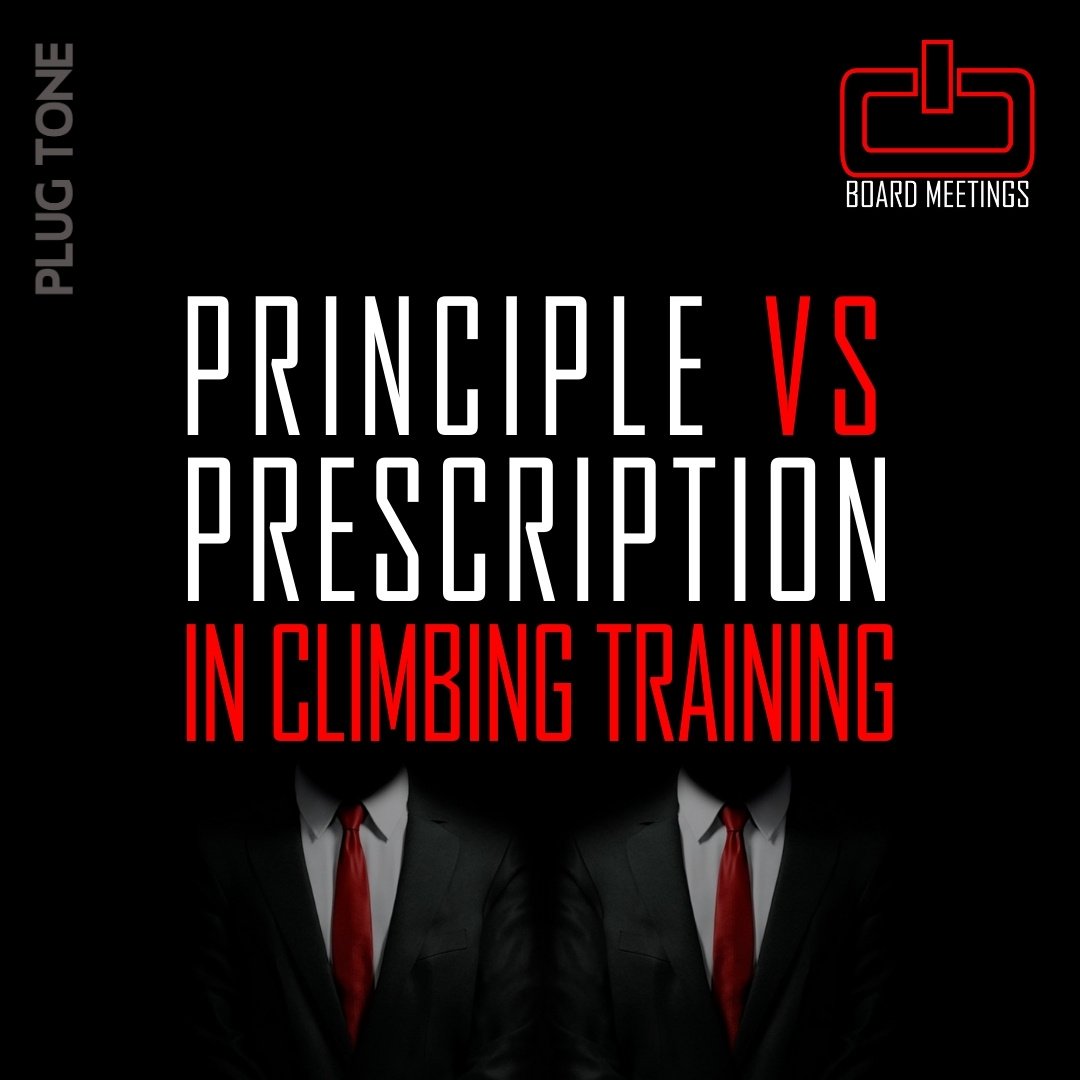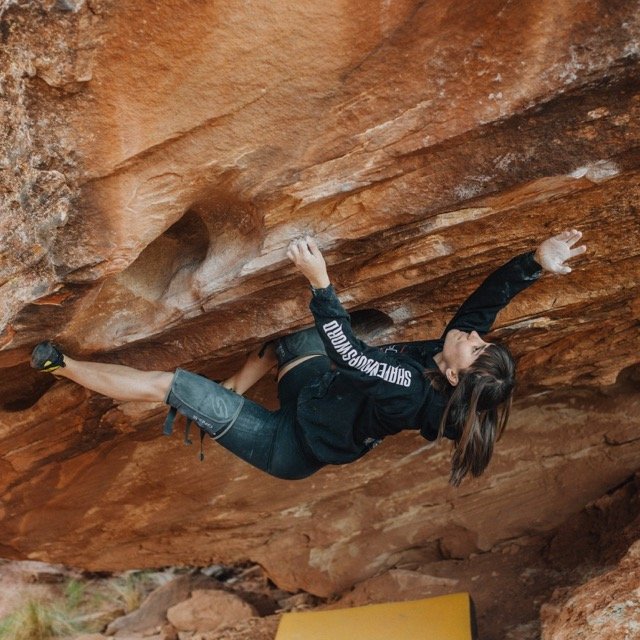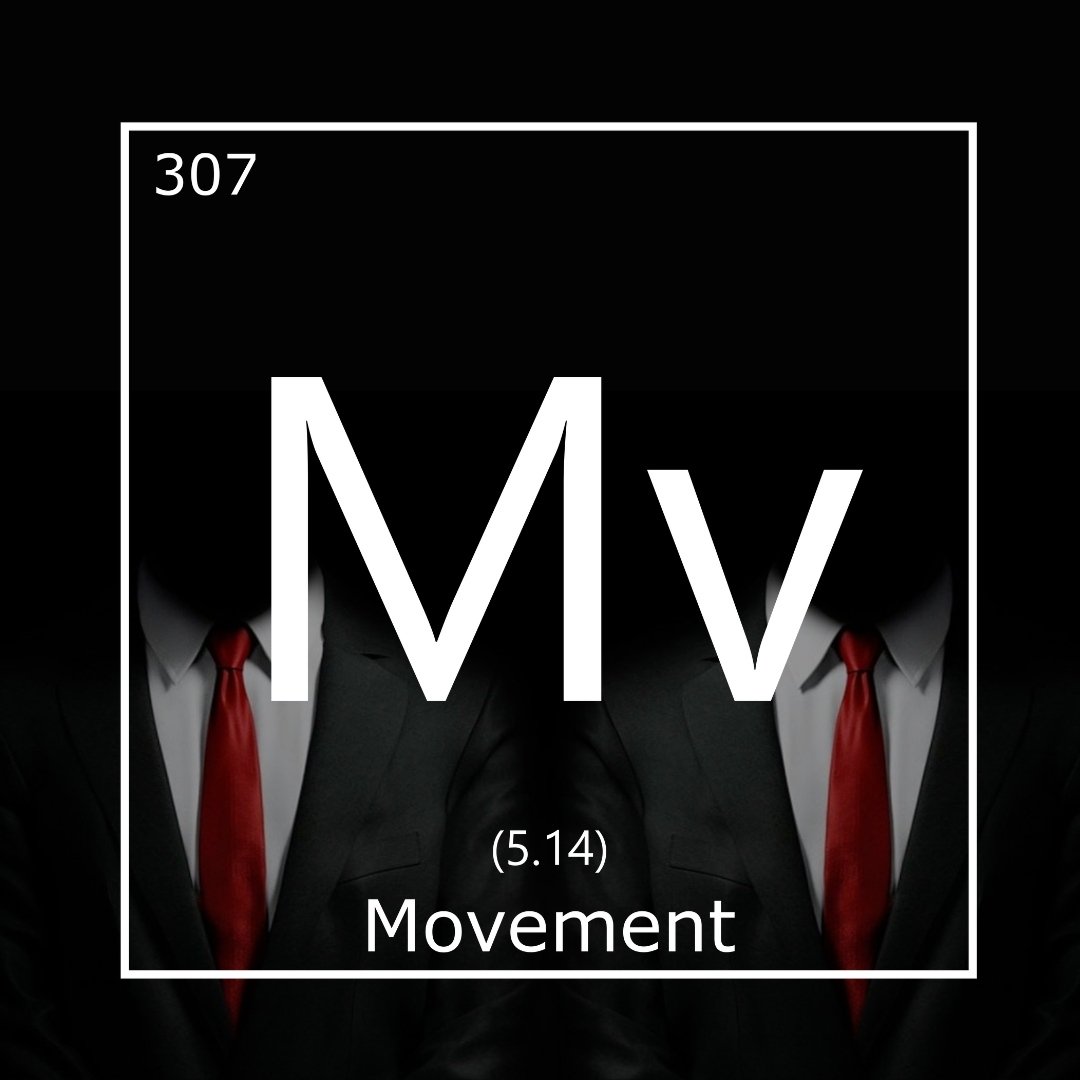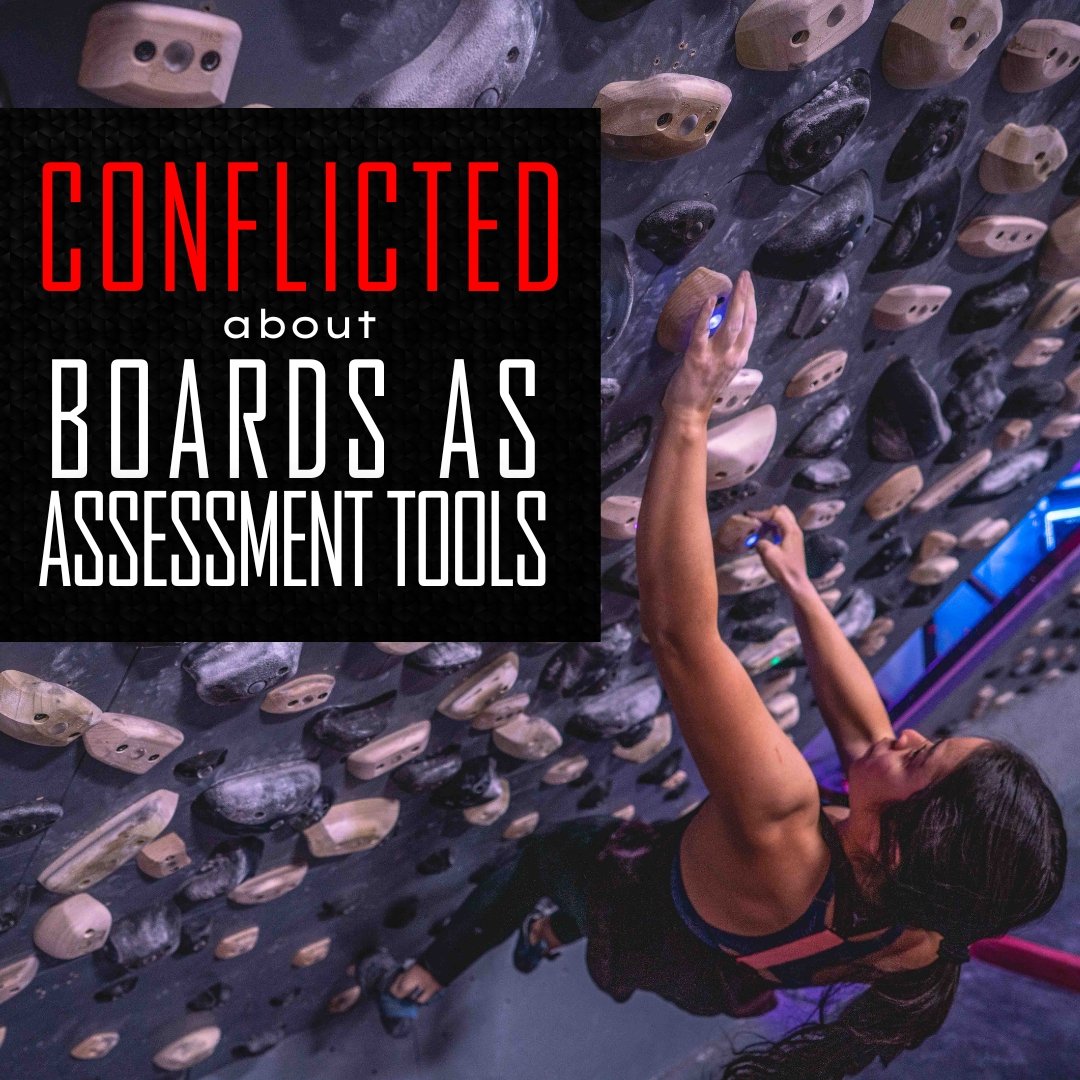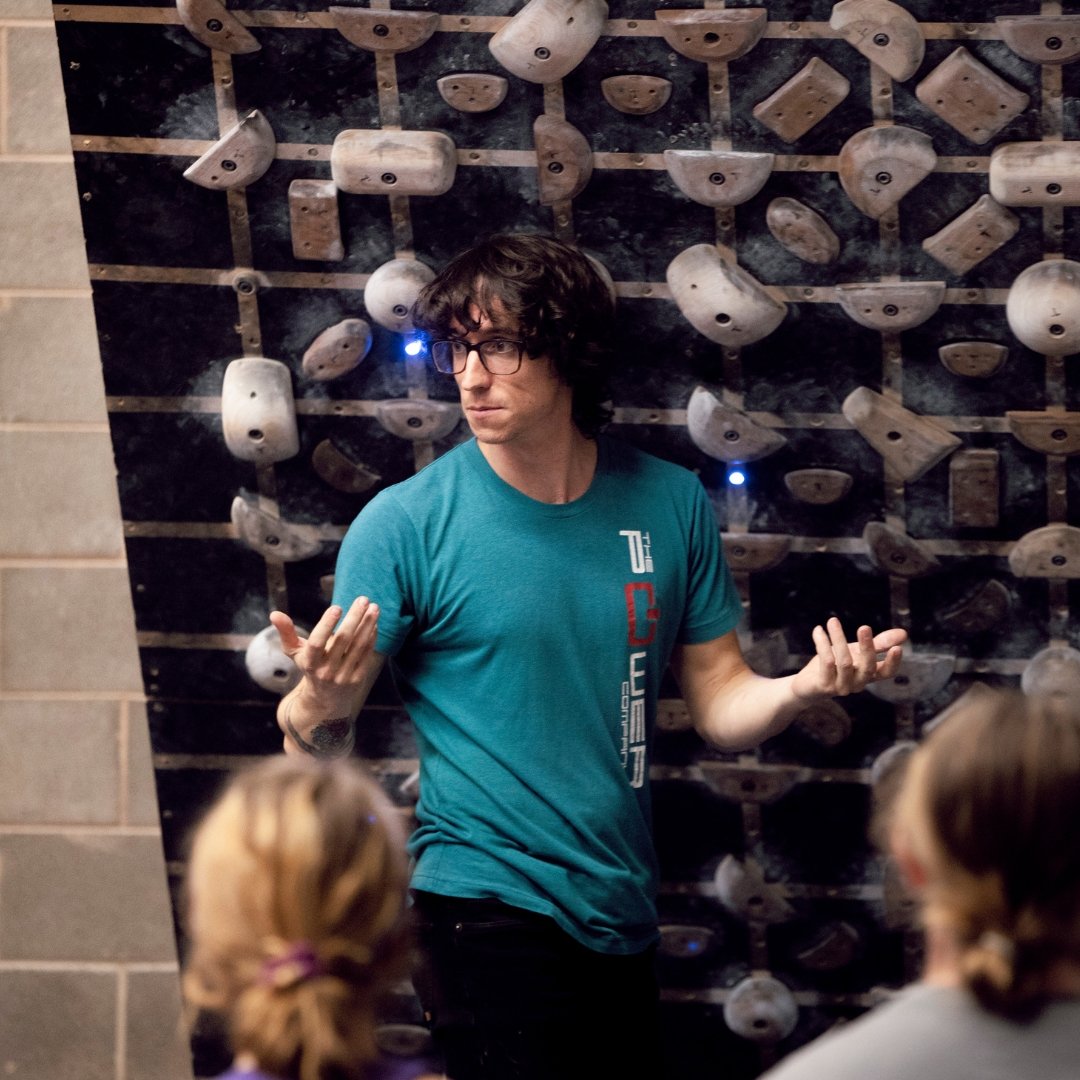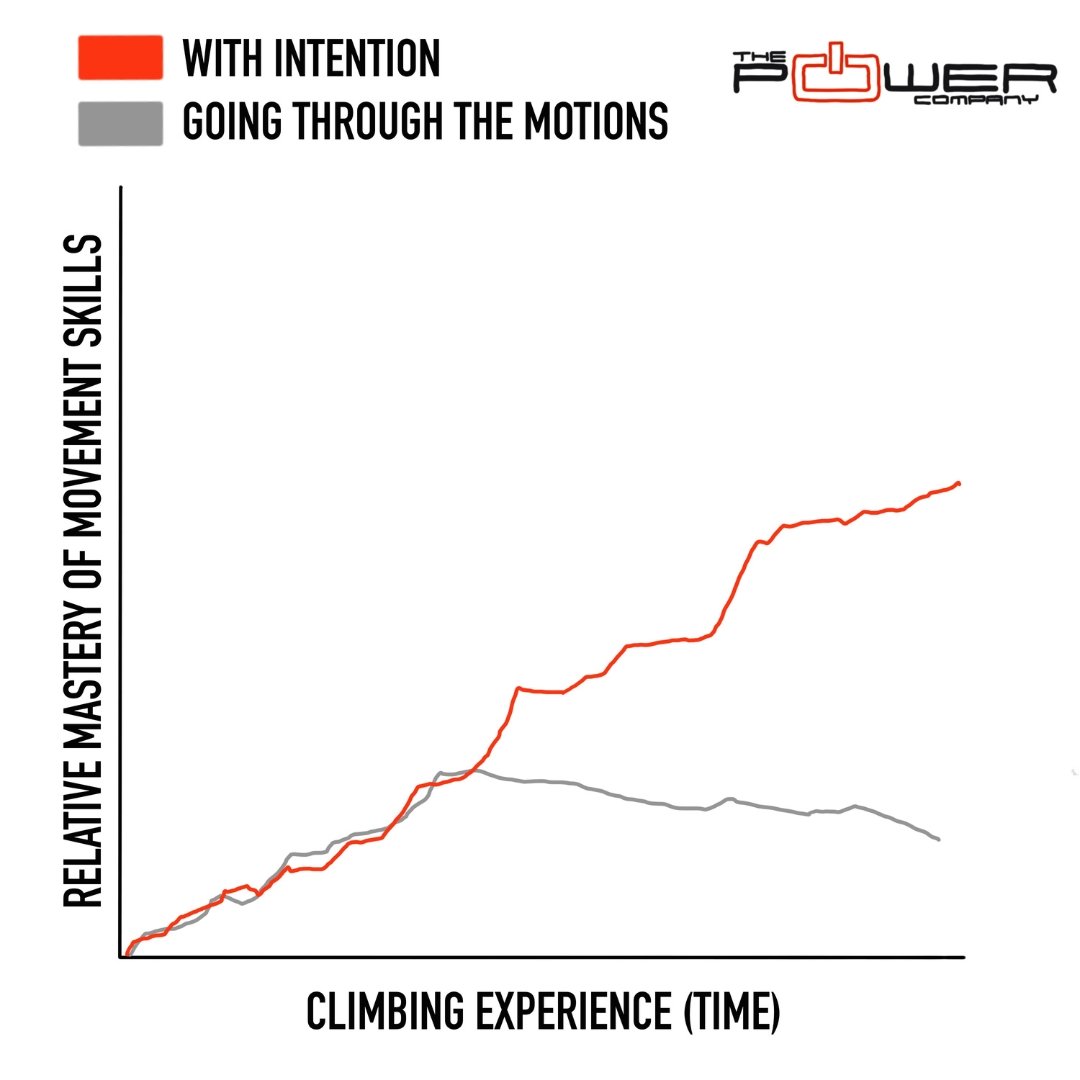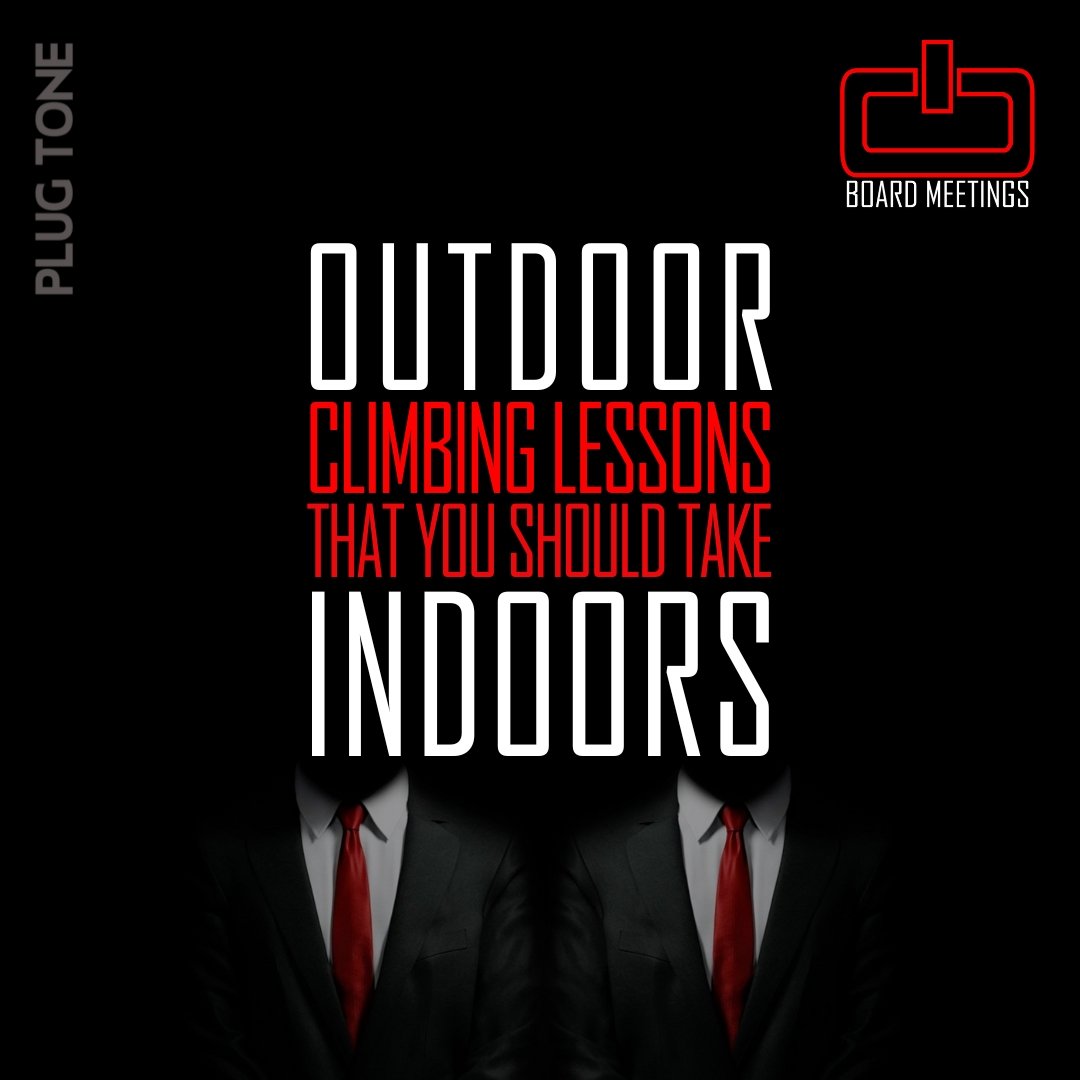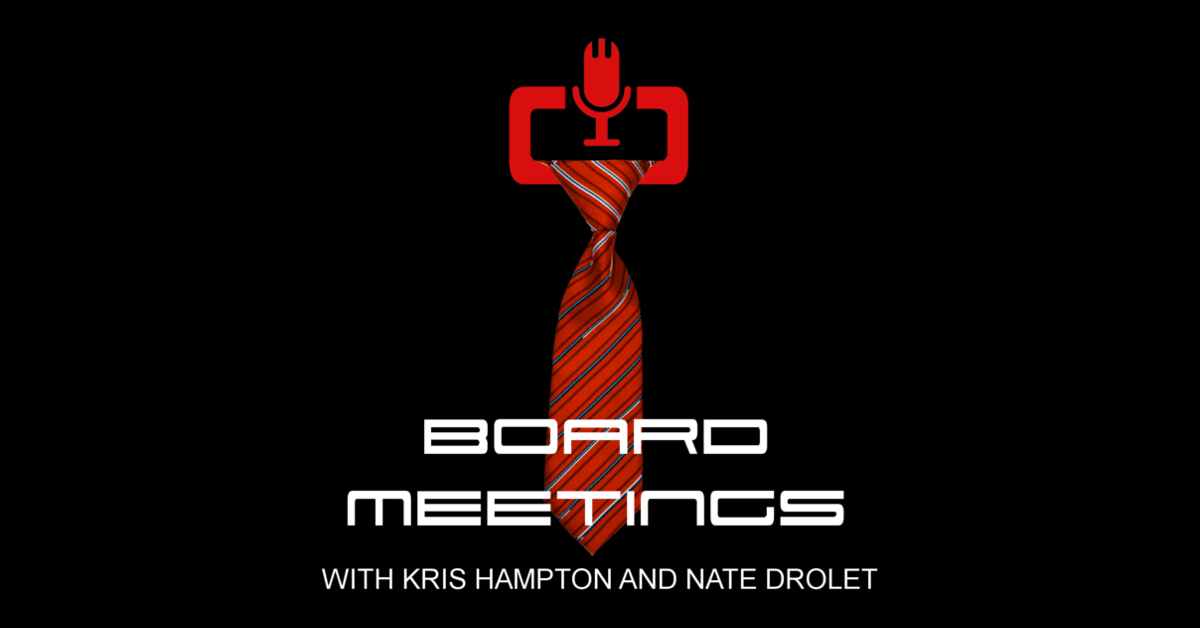Board Meetings | Lowpointing: The Most Overlooked Climbing Tactic
You know what highpointing is, and definitely redpointing, but what about lowpointing? And for those of you who know what we’re talking about, do you actually do it? Chances are, you’re not using this tactic to its full potential, which means you’re not using it to your full advantage. In this episode, Kris and Nate discuss the tactic of lowpointing, when and why you should use it, and some of the reasons why it remains one of the most overlooked climbing tactics, despite the fact that it could speed up the sending process for many folks.
FULL EPISODE TRANSCRIPT:
Kris Hampton 00:36
What's up everybody. I'm your host, Kris Hampton.
Nate Drolet 00:39
And this is Nate Drolet.
Kris Hampton 00:40
And we are in lovely Lander, Wyoming. Nate's been here for a few days. And we've both just been tearing apart all that is good and holy about climbing and training for climbing and the social media of training for climbing. So now we're gonna talk about something good and fun instead of tearing apart all that's good and holy,
Nate Drolet 01:06
Yeah. Contributing.
Kris Hampton 01:08
Yeah, one of the fun things we've been doing, though I'm not gonna give away too much is that we've been sort of iterating on a new series. For the podcast, I'm going to be switching things around a bunch here pretty soon, just because I'm bored with doing the same old thing that I've been doing. And now that now everyone is doing, and there are lots of people doing it really well out there. So why not switch it up and do something totally different. And we've been coming up with some fun pieces for that, which I'll be sharing soon. Today, we're sort of taking a look back way back in the catalog. Years ago, I don't know what year it was. We did a second go sin board meeting. And that's been really popular. I think people really liked the like nerdy digging into a single tactic. And we decided to do the same thing with a, with what might be the most overlooked tactic in all of climbing.
Nate Drolet 02:22
Yes.
Kris Hampton 02:23
Gotta be close. If it's not the most overlooked.
Nate Drolet 02:25
Yeah, as far as tactics that are just hiding in plain sight. Yeah, this one is very overlooked.
Kris Hampton 02:31
Yeah. And that's the lowpoint method. If you haven't heard of the lowpoint method before, you don't know exactly what it is, but you've heard of it. Nate, will you explain it for folks?
Nate Drolet 02:43
Yeah. So low pointing is essentially trying to send either the boulder over the sport climb from higher than the ground, but lower than however, how you've done it before. So sport climbs is pretty common. Should be but for a lot of people, the way they end up trying sport climbs is, you know, they climb up to the crux, they fall pullback on, do the crux go to the top, and then they just repeat that forever in maybe they send Yeah, so a low point would be, let's say you go up and you fall at the crux, a very classic way that I like to recommend is lower one bolt, then see, can you do the rest of the rock climb from there. And then ideally, with low points, just like how you want to be pushing your high points higher and higher as you go. Do about a projecting process, you also want to be pushing your low points lower and lower. So let's say you fall at the crux again from the ground, then you can lower two bolts and try it from there. If full bolt jumps end up feeling too big at some point, you can do you know, just, you know, a bolt and a couple moves, things like that.
Kris Hampton 03:57
And I don't even think you necessarily have to only low point when you've fallen on your high point. I think it's a convenient time to do it. Probably the most often used way to do it. Yeah. But if you are planning well, and if you understand the route, well there are some scenarios where just going bolt bolt up to a new low point is a good idea. And then, you know, trying from there while you're fresh instead of just after you've fallen. I think there are benefits to both methods.
Nate Drolet 04:31
Absolutely. And I mean, you don't even have to bolt bolt. You can look at Adam Ondra like in the flat anger cave. Yeah, you know, he digs up a rope jugs up a rope. So he was low pointing. Like that's how we climbed so many of those routes was he would pull on from I think still like eight bolts and even though it's like 30 feet off the ground. Yeah, you know, because everything is weird. They're super steep. Yeah. That is like that's also an option but bolt bolting super classic. Also, if there's linkups, you can even climb an easier route next year project and then you can take that bolt or just link straight into it. So
Kris Hampton 05:11
Pull on draws, stick clip through, whatever you need to do to make it work for you. And I think, you know, high pointing is definitely the method most people are familiar with. It's, I would call it the most overused tactic. It's a great tactic. It's a very valuable tactic, but it's essentially just giving redpoint burns. Yes. You know, unless, you know, oh, I'm going to follow up there somewhere. Not sure exactly where, but you're still living with hope that you won't fall?
Nate Drolet 05:44
Yeah, I think pipe pointing can definitely be a good tactic. For I mean, especially if you are honest with yourself, you're like, okay, like, I'm early in this process. I'm just going to try on stress test my beta, and a tie in from the ground. Yep. Go really hard and see, kind of where the wheels fall off. Yep. That can be awesome. And, you know, it's useful, but that is, I don't think used, it's not used in that way. quite as often. Most people are like, I'm just gonna keep going until I fall and kind of with that hope of like, maybe I'll send right.
Kris Hampton 06:21
Yeah, I think you're right. Why do you think low pointing is so overlooked? It's such a valuable tactic. It could speed up the process for a lot of people a lot of the time. But you and I have both made the mistake? I'm sure it will classically. Yeah, not lo pointing soon enough in the process or not at all, and then dragging the process out for much longer than it needed to be? Why do you think we avoid it?
Nate Drolet 06:54
You know, I think there are a few reasons. To that really come to mind for me. One is that. One, is that ego? I mean, essentially, because if you can't send it from, if you're like, let's say you're falling at the fifth bolt, you know, of a 10, bolt, rock, climb fault, the fifth, and then that's where the crux is. And you go to the top from there, you're like, Oh, well, I guess I could do it from the fourth, you know, lower down one bolt. But if you can't send it from the fourth, What business do you feel like you have trying to do the whole thing? Yeah, I feel the same way. Like, it really puts you in your place. It's humbling like that. Is that something that? I think stops a lot of people, it certainly has stopped me. And it doesn't always feel like a conscious thought. Like, I'm not like, oh, no, my ego won't be able to handle this.
Kris Hampton 07:47
Yeah, like you're almost scared to admit, I might not be able to send it from there.
Nate Drolet 07:50
And that's exactly how I would describe it. Like, I know, I'm choosing the right link to go for the right low point. If I've got some butterflies if I'm like, ooh, I've got like that kind of redpoint jitters for trying to do a rock climb from you know, nine volts and or whatever. Yeah, like, if you if I get a little bit of jitters trying to go for this low point. I'm like, okay, yep. This is it.
Kris Hampton 08:11
Yeah. If you feel unsure about it, if you're like, I don't know, if I can do it from there, then that's the that's the one you should be doing. You know, we've said that about links before and this is just a different version of a link. Yeah. Yeah, I think that's true. And when when you feel those jitters and you're afraid of it, and then you avoid it, essentially, what you're basing your success on? Is hope and luck. Yes. What you're saying is, I don't have enough mastery to drop down a bolt and send this thing and feel like I could consistently do that. So what I'm going to do is cross my fingers and hope that somehow I magically make it one time.
Nate Drolet 09:00
Yeah. And here's the thing, like, here's where we get in trouble. Is luck is real.
Kris Hampton 09:06
Totally. It is like I think I've sent things on luck. A number of times.
Nate Drolet 09:11
It's got a story I'll tell a little bit later where a tremendous amount of luck came into play. But I think luck in rock climbing is highly underrated. It's one of those things that like, I think a lot of us are like, No, I build my arm, you know, I make my own luck, like luck. You know, luck doesn't happen to me. I happen to luck. Kind of like I happen to love that kind of thing. You know what I mean? Like, yeah, because and I get it like luck is like the along the lines of like privilege almost. And you're just like, no, like, I do the work. I don't want to be associated with luck. But man, luck is an absolutely real thing. Like sometimes you just hit the holes right on your first time. Yeah. Without even realizing it. You're like, oh, that just like went well and that wasn't bad, but maybe if you tried to repeat it, it would go terrible. So the thing is, sometimes we do get lucky. And we don't. Rock climbers, probably just people in general. Were really bad about understanding how odds work. Yeah, most Yeah, most people are like, we will have, let's say, you pick 10 projects. And you're like, Okay, I'm going to try and low point one of them the rest, I'm going to try and just keep trying to high point. Like, you're probably gonna get lucky and like, just happened to high points successfully on one of them. Like, it's going to work well, and you're like, Oh, this is great, even if the other eight went terribly. And it's like, dragged on to these long campaigns. And the low point might end up being somewhere in the middle. Like, because you aren't leaning on luck as much, you're kind of playing the odds, you're solidifying things in your own way. You're playing it safe. You're playing it safe. Very much so. So it might feel like a slow way compared to the super lucky goals that you get now in then. Yeah, but if we look over the course of all of our climbing, man, like lowpointing is such a great tactic.
Kris Hampton 11:14
Oh, yeah, I bet I've spent over the course of my climbing, I bet I've spent hundreds of attempts where I thought, all I have to do is get lucky one time. Oh, man. Yeah, I just had to get through this one move. And then I don't, and then I don't, and then I don't. And then I don't. And I could have been low pointing, and which is playing it a little safer. building up confidence building up fitness in a different way. As opposed to just feeling like, I'm gonna get lucky one of these times. Yeah, you know, and I also feel like the idea of getting close. And I and I use that in both ways, like, Oh, I was close to sending, but I was also geographically close to the anchors or something, you know, are geographically close to the point at which I'm no longer going to fall. That can be really, that can trick you into thinking you're actually close. And the problem with a with a lowpoint is that you aren't close, you can't send there's no chance of sending when you start a lowpoint, but you've, you've deleted the chance of sending just by choosing to do a lowpoint. I think that's tough for people, like the specter of sending needs to be there for people to feel like it's worthy.
Nate Drolet 12:46
Absolutely. You know, and earlier, I was saying there's kind of like two main reasons why people back away from this. And I think this is the second one is, like, they kind of feel it almost feels like it's stealing energy away from sending like, you're like, Well, this is energy I could be putting into giving good redpoint goes, Yeah. And also like, not everyone, I think your arousal rate can definitely be affected by low pointing like earlier, I said, all like lower until I get jitters. And I'm like, Okay, this is the spot where I'm like, Cool. You know, I'm nervous to try this. But for some people, just the fact that they said take and they stopped, and they're no longer on point and they can't send, they can't try hard. Like they really struggle to rev things up and say, okay, like, I'm going to knuckle down just as hard as if this was a said, go. And that's what you need. Because if we're going to stress test our beta, if we're going to make sure everything lines up and works well, and also like test our fitness appropriately, then we need to give 100% effort. And for some people that's just not like they struggle with that a lot.
Kris Hampton 13:59
Yeah, for sure. I definitely get that. And I think learning the skills of giving the appropriate effort are really valuable. I mean, obviously I've talked about this at length on the podcast, but learning to not only rev it up when it needs rubbed up, but also back it down when it needs back down are valuable tools. So if you are that person who's like off, I'd say take I'm just out of the game, I can't get my head back in it. Maybe this is actually a good thing for you to practice very much climb up to Bolduan and say take and then try to go from there. And and you'll know by bolt three, did I turn it back on have Am I at the appropriate place or not? Do I just not care anymore? Because I know I can't send? Yeah, you know. And honestly, when you're working on your hardest rock climbs, you're going to have to be giving high levels of effort on just getting links done early in The process? Yeah, you're just getting moves done, you know? So you might as well start learning that now. Yes. I also think lowpointing just feels like a step backwards. For a lot of people very even though it might not be even though it might be the next logical step forward. It feels like a step backward.
Nate Drolet 15:21
Yes. I mean, especially like, if you've had like a good go or like, if you're, you've convinced yourself, you're like, Oh, well, I'm, I'm, I'm at the point to where I'm red pointing. And then, you know, maybe you have a few goals that tells you otherwise. It feels Yeah, it feels like you have to recede. Like, you have to say, oh, no, I'm, I'm not ready to redpoint I need to go and do some more work. That's tough. Like, that's not that's not a fun place to be in, in the faster you can just admit it and say, hey, you know what, I've got more to learn more to gain. I'm going to step back and do this, you're probably going to end up saving yourself a bunch of time in the long run anyways,
Kris Hampton 16:04
yeah, I can't tell you how many times I or a client or someone I'm climbing with, is like, Oh, well, I'll try. If I don't send this next go. I'll try low pointing. And then they don't send and they're like, ah, next go for sure. But don't send that go. I'll try low pointing. So close. Next, go for sure. You know, and then it just never happens. Yeah. And eventually they send because they've beat it into the ground. Which I'm not saying it's a bad thing. But they send and then they're like, I'll see I didn't need a low point. Yeah, yeah. But if you had low point, it's 17 attempts ago, you might have sent the next attempt.
Nate Drolet 16:43
Yeah. Yeah. And you, there's this thing that people will start to do, which this is adopting, in, what I would say is maybe an advanced or even elite tactic, way too early, or, like, kind of becoming married to it. And that is the tactic of you go, you fall at the crux. And you say, Well, I know what the rest of the boat the rock climbs, like, I'm gonna save energy for my next redpoint go. Look, this is a high level skill. Does it work? Absolutely. I've done it plenty of times. Have I been burned so hard? By this? Absolutely.
Nate Drolet 17:19
Absolutely. Like, some tragic moments have happened, because I like employed this when I didn't have business doing it. And this was not long enough ago for me to like, blame. Oh, I was just young and dumb. It's like nah, I, I should have known better.
Kris Hampton 17:35
Yeah. Where you're like, you're, you're past where you thought. Got it in the bag now. And you're like, I'm about to fucking fall right now. Yeah,
Nate Drolet 17:45
that's like the anti lowpoint is like going up going to where you fall? And you're like, Well, I'm going to save energy for my next go. So I'm going to lower and then try again, you know, instead of going to the top, yeah. versus, you know, and, yes, there is a place for that. There's a time for that. It is a great tactic, when used correctly. Yeah. But yeah, that's the that's the opposite of low pointing. Instead, you should be like, Hey, I'm going to stop, take some steps back rebuild, like and go from there.
Kris Hampton 18:16
So if you're, you know, if you're one of these people, yes, I'm talking to you, driving your car shaking your head. I know you
Nate Drolet 18:25
In your Subaru.
Kris Hampton 18:30
True. If you're one of these people who's still like, yeah, so I'm still not going to low point, you know, still doesn't still doesn't sound like it makes any damn sense. Why is it valuable?
Nate Drolet 18:48
I mean, a couple reasons. One, I think that's worth keeping in mind is, honestly, it's good for fitness. Like, you will get more fit from doing low pointing, like you just do more moves.
Kris Hampton 19:02
Yeah. And I think it flips the, like the high point method can also get you more fit, but you're getting fit on the moves, you're not falling on. Yes, the low point method allows you to get fit specifically in those moves where otherwise you're falling. Yes, I think that's a super helpful piece of it, you know, especially having both in play, where you're getting high points and your low pointing through to the top. You're you're building that fitness across the whole route instead of just up to the point where I fall. I'm really fit. And then I can't do it anymore. Yeah.
Nate Drolet 19:44
And then I stop and I rest, and then I do the top slightly rested. Yeah, so this is good for building fitness. In developing. So the term for what Chris was just describing as an overlap, so pushing your high point high and low point lower creates a bigger and bigger overlap of those two pieces, right? If you ever hear people describing overlapping links, that's what they mean. Ideally, you want those links to become as overlapping as possible. Until you send.
Kris Hampton 20:14
Yeah, you can, you can move the one hang up the route and down the route. And that becomes a really important thing. The one hang doesn't you know, if you're one hanging out the last bolt, that's, that's not necessarily better than one hanging at the first bolt.
Nate Drolet 20:31
No, no, but it feels better.
Kris Hampton 20:33
It does feel better. And it looks cooler.
Nate Drolet 20:35
It looks way cooler. Yeah, it's so does a few things. Its stress test is stress tests your beta up high, which is really important. Because if you're only doing your upper beta fresh, you need to know what that's going to feel like under fatigue. Yeah, like, especially a lot of sport climbers, or boulders, even. We get very guarded, the closer we get to the chains, like the closer you get to the top of the climb, the more you want to climb defensively instead of offensively, you know, you're no longer climbing descend, you're climbing not to fall, which often means we go slower than we should we try and lock things off more than we should. And these are very energy consumptive ways of climbing and low point and can sometimes tell us hey, you're not that guy. Yeah, you're not locking off that last minute. Yeah, totally. You better find a good push foot because you're hucking.
Kris Hampton 21:36
Yeah, you can lock it off, and you're fresh. But when there's some pressure put in here, the cracks start to show. Yeah, and you can't do that anymore.
Nate Drolet 21:44
Yes. And I will say, I think climbing, low pointing, there's always a point in the process, will you where you will be more fatigued up top, low pointing than you ever will be on a redpoint? Totally. Because let's say you know, 10 bolt, sport climb. Let's say you climb up to the seventh fall, lower down to like the fourth. Now, why do I do math? Let's just say now you're having to do like 15 bolts of rock climbing. I hope that's right. You have a new like 15 bolts of rock climbing, instead of just, you know, the regular 10. So when you get up to that top, you're going to be so pumped. Even if you stop and rest for a little bit. There's a lot of cumulative fatigue that builds up, man, I find the best redpoint Crux beta on big low points where I am pumped out of my mind. Yeah, more often than not, that will be the most fatigued I will ever be. Versus when I'm giving a redpoint go and I'm you know, taking long 45 minute hour long rests between efforts on the route like I'm primed. Everything's going well. I probably won't be quite that pumped. So my beta that I find all low pointing, guaranteed to work.
Kris Hampton 22:54
Yeah, whenever we, you know, we see it happen all the time, when you put that constraint into place of like pre fatiguing. Your, your technique changes a little your like ability to find rests, changes, your efficiency changes for the better, because you're in like, survival mode at that point. Yes. And you have to find these things. And it'll like you said earlier, it'll let you know, like, is locking off here going to work? Is doing this move. Statically going to work? Maybe not. So it's a it's a really valuable thing for your beta. Yes, to get there tired.
Nate Drolet 23:41
Yes. And one thing that can also help, you know, I've talked a lot about kind of arousal rates in this, but for a lot of people low pointing can feel a little less stressful. Yeah, because you're not especially up high. Let's say you know, you're in, you know, let's say you're on a 5.13 and you're at the top and it's you know, maybe 11a, maybe 11b, harder than you want. Frankly, you're like, Oh, I'm kind of trying up here. Something about not being on redpoint where you're not just you know, it just
Kris Hampton 24:12
It removes expectations. Now I have to send
Nate Drolet 24:17
exactly you can kind of gives you a little bit of breathing room. You can say okay, cool. Like, yes, like I want to do this right now. But I can relax a little bit like I am pumped. Let's take our time, fine beta. And I've always found it like, it really lets me take my time and find beta rather than just being absolutely just scrappy, instinct and emotion like get me to the chains.
Kris Hampton 24:42
Yeah. There's there's a fair body of research. You know, talking about this phenomenon that we hear coaches mentioned all the time. Or, you know, athletes mentioned all the time that's like, Oh, you're just too in your head or you're overthinking it. And that's why you're failing. And that happens to us a lot of the time when the expectation is to send, especially as things start getting tired, or pumped, you start overthinking it, you start, like running through this checklist, like how do I feel in my body? But your mid crux? No, that's not the time to be going down this checklist and realizing, oh, fuck, pumped, maybe too pumped to do this move. That's not the time to be doing it. So this, this idea that you're too in your head can be a real thing when that expectation is there. And there's a fair body of research saying, if we can get out of our heads, and let our let our bodies do the thing that we've taught it to do. Them will, will perform better. And I think the low point, removing the possibility of sending can be a really good thing, because they're the expectations drop away when it's like, oh, I can't send now, you know, you're still going to have some expectations, because you're trying to accomplish a specific thing. But it's not the same as this is the sin. This is it right now. I'm about to do it. Fuck I missed that hold. Yeah, you know?
Nate Drolet 26:20
Yeah. No, I think that's a great point, is lets you experience some of those things like, oh, yeah, you know that you're going to be skipping the bolt up high. And it's not that bad when you do it, after hanging at the crux for, you know, two, three minutes and then doing it. But having to claw your way through a little bit pumped. It's good having to experience that a few times first. So that when you're on redpoint, you're not thinking about a bow, that that is way more scary than I realized it was going to be. You're just like, hey, yeah, this is intimidating. But I've been here, we know what we're doing.
Kris Hampton 26:57
Yeah. And yeah, that builds the confidence for the top. You know, that's, I think that's one of the most important pieces of the low point is just building the confidence that you can climb through the top. And then, you know, someone would counter with, but what if I fall on the low point? And then we're back to? Well, if you can't do it from bolt for what makes you think you can do it from the bottom? Yeah. You know, maybe you'll get lucky some time and get through it. But why just rely on hope? And luck? Hope is not a strategy.
Nate Drolet 27:32
climbing on a prayer. Yeah, yeah. It I mean, if you fall from both for that means you got some work to do. Which is great. Like, that's, I would rather have that happen early on. Yeah. It may be like, Oh, okay. Like, there are things to, to improve upon here. Rather than think going in and being like, Nah, I got it any moment now.
Kris Hampton 27:58
Yeah. And a lot of people will low point like, to arrest. But then they're like, well, there's a rest here. You know, why would I low point below that? Why would I climb two bolts into the rest? That's silly. And I'm like, Well, I mean, unless you're Jonathan Siegrist. And have completely mastered the art of resting so much that you know, very intimately exactly how you feel when you're ready to do the next bit of climbing. And you're not Jonathan Siegrist. But unless you were, this is a really valuable thing, because you're still going to get a little pumped from those two bolts. And you're gonna have to shake it out. And you're gonna have to then face this top section where you keep falling off. So I think it's an easy trap to fall into to not go below and obvious rest.
Nate Drolet 28:50
Now, man, it's, I this is such a. I mean, this is something all sport climbers have to go through at some point boulders to I think boulders are a little better at doing links. Because, you know, it's like three moves, bro, do think like, what are you doing? Yeah, like, if you're not doing links on boulders, you know, maybe you're a brand new climber. And that's totally fine. The links don't matter quite as much then, like, you just need the experience of moving. But if you're not doing links on boulders, you got problems. But for sport climbers, we already kind of do the links, we just need to be doing the right ones. Right. And I will say, this is such a classic thing that every sport climber has to say. And they're gonna have to eat their words at some point, and it's, oh, why would I do a low point from there? I mean, I've basically any lower than where I'm going from right now. You might as well be sending it right. You know what? Hey, like, I hear you. I've heard you. I've said those words. I have eaten those words. enough times. Just do the link.
Kris Hampton 29:56
Yeah. On Swingline. For me, it was like I can climb this whole top section. And I've low pointed to the rest. Why should I go lower? You know, I can get almost everything back at this rest. I'm pretty sure. Huh? And I was good at resting at that point, like I understood resting pretty well.
Nate Drolet 30:20
Yeah. I mean, you did like the link up to the rest as part of your warmup didn't you? Yeah. Yeah, easily. I mean, basically you said it, if you went any lower
Kris Hampton 30:30
I felt like I get to the rest pretty fresh. Yeah. Like, why on earth? Would I go any lower? That's stupid. And I did that I felt the same move for. I don't know how many times 30 or 40? I don't know. Yeah, a lot, a lot. And then two things happen simultaneously. So I don't know which to give all the credit to you know, but I bet it's partial credit to both. I made a slight beta change because I saw somebody else do it. Who I thought he was too tall. And there was no way I could do his beta. So it still took me a couple weeks of falling to be like, fine. Let me try that other beta. And I'm like, oh, that's three V grades easier way I was doing it. But then I also said, Okay, fine. I need to low point below the rest. So I dropped to pretty much the start of the like, small pocket section, which a lot of people consider to be around 13a. Yeah. And for some reason, in my head, I was like, I'm too cool. To climb this 13a section into the rest the I'm too good at this section. You know, I was an idiot. And I sent as soon as I changed my beta and started low pointing. Yeah.
Nate Drolet 31:50
Yeah. So I got two stories. One very brief. Basically, when I was working on proper soul, which became my first 14 A, I fell, I kept falling in the same place over and over and over. And then finally when I fell, and I whipped super low. Oh, no, that's not what happened. I had a foot slip really, really low, like a place. Why would I ever link from here? It's so low, I'd basically be ascending. And I was like, You know what? My like, My foot slipped. I was like, okay, whatever. I'll go for the link. And I had tried this. A lot of days. At this point, I was falling much higher. I was falling like five bolts above this. pulled on, took it to the top. And I was like, oh, literally the next day at like, rested the rest of the day came out the next day sent it. Like I just needed the accidental low point. Yeah. Because I had been like making the mistake of just all the crux go to the top. Yeah. Different story. And so this is one that like, I've put a lot of thought into, and it made me question low pointing for years.
Kris Hampton 33:00
This the third third millennium? Yeah, I've heard this story.
Nate Drolet 33:04
So I have a new take on it, frankly. Okay. Yeah, I've like just finally, I think I learned the lesson. I hope. So I went out and was trying Grand Ole Opry, which is like 14b/c, at the monastery. And I've been trying it for a while, got a bunch of links felt pretty good about it. But it was so hard. And it's very bouldery. I just wasn't doing a lot of continuous moves. So I was like, Okay, I'm going to take a step back, I still have some time left in the season. I'm going to do an enduro line, like I had already done the 13c on the cliff, that there's like a 13c slash 14a, that's very endurance based. And I was like, Cool, I'll go climb that. Spend a few sessions do it. Come back to Aubrey with a little more fitness. And I go up it on my end of my second day, this is like fourth go ever on it. I fall, go into the fourth bowl. And I was like, Okay, I'll just like, come down. I'll brush lower all the way to the ground. And then I'm going to try and just push a high point, you know, see where it was. And I get down into my feet could almost touch the ground. Like my belayer could have untied my shoes if they wanted to. And I was like, You know what, I'm just gonna go for a link from here. I don't know why I said this. No idea. I pulled on two moves in and had the luckiest and best climbing I've had, you know, in years, everything clicked went perfectly. I tried very hard but managed to stay composed. And I sent it from there from two moves and first two moves are not hard, especially like I don't find them challenging. But it was a fight and everything went well and like I didn't know a lot about route yet. And for the first time ever, on a route. I got really really nervous from a low point and then ice I think another eight or nine days on it falling at the crux, like, halfway up. And I would fall at the crux work it out, man, I would even run laps on the crocs. But I got to the point, I could do five, six laps on this route a day, go up fall at the crux. Like I wouldn't even have to chalk my hands, I would just like, immediately pull right back on, take it to the top. What? And this taught me a couple things like one, this was the first time I had a real mental struggle on a route. Now, here's something that finally clicked the other day, like, because I was like, Oh, this is like the first time forever. I was like, this is the first time low pointings ever backfired on me. But I realized, I never went back to lowpointing.
Kris Hampton 35:44
That's what I was gonna say. Did you ever do another low point?
Nate Drolet 35:46
I never did. I went straight to fall at the crux pull back on go to the top. And I did that for like nine more days. I mean, that's like one of the most I've ever most amounts of pitches I've ever put in on a route not sent it. Yeah, I, because in my mind, I was like, well, I already did the low point. Right. I never went back in the result like that would have. That would have been such an easy answer of like, oh, let's start at the fourth bolt. Yes, go from there. And because I was only falling from one move, I was like, let's do it from the fourth. Let's do it from the third second.
Kris Hampton 36:21
And you could say, All right, I got lucky. Had a lot of things go right on this low point. But what it proved is that I have the fitness to dues route. So now let's iron out all those lucky parts. Yeah. And let me start low pointing again.
Nate Drolet 36:40
The I got so in my head. I can see that. I mean, it's tricky place. Yeah, it really is. And it's funny because it I mean, this was like 2019 I think. And I think it was just last month. It was like a few weeks ago that it finally dawned on me. I was like, Oh, I was like I did the thing. Like were you just where you're like No, no. Next go. Why would I low point lower? But yeah, I just didn't connect the dots like that would have made more sense. It would have I probably would have had to spend a full day of being like, okay, we're just going to low point lower. But I spent like nine days not doing it. What's one more day I could have maybe like, I could have saved myself like seven climbing days. Yeah.
Kris Hampton 37:25
Yeah. And maybe you would have it sent now. Yeah, yeah.
Nate Drolet 37:29
Now I Yeah. So I gotta go back to it at some point. But and I'll low point when I do. But I think about I think about that rock climb often.
Kris Hampton 37:39
Yeah. And I mean, that sort of brings up the next question. Like, we know that it's valuable. But But when, because there are going to be scenarios where it's like, maybe it's not that valuable to continue low pointing. So how far do we take it? And what did these scenarios look like?
Nate Drolet 38:03
I don't recommend two moves from the ground.
Kris Hampton 38:10
Unless the first two moves are a really hard Crux you haven't figured out yet. You know, totally fair. I think that's a Yeah, that's actually a really valuable time for this is when it's like super low crux. And I would low point all the way down to the top of that crux early in the process. Like that might be the first thing I start doing, like work out the crux moves, or, you know, spend time on the crux moves every day. But also be thinking low point. Because when I finally get through those first two moves, I want to be able to go to the top, you know, yeah, that's, that's luck flipped. Like, I could get lucky on those two moves, and then never do them again. So I want to make sure that I've low pointed all the way to the end of that crux section, so that when I do get lucky, or if I get it dialed in, whichever happens first, I can just go to the top.
Nate Drolet 39:10
Yeah, there's a phrase I use my clients all the time. And that's plan for success. Yeah. Like, yeah, looks great luck happens, you better be ready for it. Like, I can't count the amount of times that, you know, people will look at a route or a boulder. And they'll be like, okay, cool. No, maybe run the crux through their head. And this is, let's say, for like a flasher on site go. And then they happen to get through the bottom. And they didn't prepare for the rest of it. Yeah. You know, and I was like, Oh, well, that sucks. Hope you're good at onside and hope you're good at all inciting Yeah. But it's like just taking a few extra moments to look at the whole thing would have guaranteed it were in this case, it's like, hey, let's just spend a full go. Low pointing making sure that when we link through that opening boulder, we do the whole thing.
Kris Hampton 39:58
Yeah. Yeah. And I think in that scenario where it's like boulder problem Crux at the bottom. You can even, you know, start from the end of the crux, and do do high points from there. So try to do big links, and then try to do big low points. So you're working a big overlap until you've got it all in one piece. And then when you get through the crux, you're gonna you're going to the top. Yeah.
Nate Drolet 40:23
Yep. That's, I think that's a great way to go.
Kris Hampton 40:27
Yeah. I don't think it's as valuable though. If you've got like, a big mega no hands rest. Like if you can just sit on a ledge. Then maybe it's not as valuable. For sure.
Nate Drolet 40:43
Like, I think it's definitely not as valuable. It's still somewhat valuable.
Kris Hampton 40:48
Yeah. Can be in some ways, especially mentally. If your capacity is really low, and you get really tired on the bottom part, then maybe you need to calm some of it before the no hands rest.
Nate Drolet 41:02
Yeah, I had. So supercharger in the red. Yeah, it's like V7 to, I mean, a full sit down hangout lodge that you can be on forever, to essentially the 13d. And the best thing that happened to me was that I would, you know, go up, try it, I could do the V7 pretty much every time I'd go up into the steepness fall, do a link from there. And then finally, I and this was from a conversation with you. I was inspired to do this. I just jumped up to the no hands. lejog Fully skip the V7. I was like this. I was like, well, this even make a difference. Huge difference. Yeah. ended up sending it from there that go and I was like, Oh, okay. Like, that didn't make a difference. I will have a little bit of extra fatigue, even if I'm hanging out for 20 minutes. Yeah. Like, it's just a tiny bit, you know, and it's a, it's a tiny, like, the 13d section you climb is only like 35 feet anyways, like, the next thing is still super short and powerful. That for me ended up being huge. I think I sent another two tries later, just from that confidence. And I think had we not had that conversation, I would have just been like, well, it's fine. It's just a ledge. I'm gonna sit down anyways.
Kris Hampton 42:20
Right? Especially when the two halves are pretty difficult. Yes, it can definitely make a difference, because most of us aren't sitting at the no hands rest long enough to really get everything back. Especially when it's powerful. Yeah.
Nate Drolet 42:35
So I agree, I think it is absolutely less useful. There are times, but I mean, frankly, yeah, if you're going up and you know, let's say you're trying to 12c, it's like a 5.10 to a sit down ledge, you know, and basically 12c from there the top, I would say, don't worry about linking from below, probably like, yeah, yeah.
Kris Hampton 43:00
I think the most common time that people think it's valuable and where it is valuable is when it's a crux at the top of a root. Yes, you know, I think it it certainly shines here. And this is a really good opportunity. Though, opportunity. sort of sounds like a positive thing. And a lot of people wouldn't see it as positive, you know, that, that you can just move your low point down a bolt at a time or even half a bolt, in some cases, depending on how hard the moves are down there. But you can gradually move that low point down. In a situation where the crux is at the top. It's really easy to get tricked into. I'm just gonna start redpointing now.
Nate Drolet 43:48
Yeah. You know, you mentioned earlier being geographically close to sending in that's the case with this, like, there. This is, you know, this is another thing that all sport climbers at some point are going to fall for. They're like, man, fallen on the last move. I'm practically sending it. It's like, hey, the last moves the crux, like, you know, just as a heads up, that's a that's where everyone falls forever.
Kris Hampton 44:13
Yeah, almost almost winning the game is still a loser.
Nate Drolet 44:19
Yes. Yeah, like looking at it from low pointing even lower, I think can be very motivating to because it gives you a new yardstick for where am I at? Like, how, like, am I actually improving because if you're just given a ribs from the ground, and you keep falling on the same move, yeah, you can be making progress like you might be more efficient. You might be showing up with, like, even more fresh,
Kris Hampton 44:45
you might do it more times in a day
Nate Drolet 44:46
might do it more times in the in a day, but you haven't improved enough to pass that threshold of actually doing the upper boulder. But if we do low points, man, we can suddenly have progress every single time you show up to the cliff
Kris Hampton 45:00
Hmm, it can be so on motivating to to fall at the same spot over and over and over. Yeah, frustrating. And most of us like going rock climbing because we like to climb on different things, you know. So getting stuck on the exact same thing, having deja vu attempts over and over again, can just be unmotivated.
Nate Drolet 45:22
Yeah, you know, and there's something to be said, for learning to fail. In the sense of, if you keep getting the same move and falling over and over, and over, you can kind of build that into a habit till you get up and your brain is just like, oh, this is where I fall. And that sounds silly, but you can see it with people who've project it for a really long time on something, they'll get up to their crux. And they like, it's almost like they have all the artifice of trying hard. But you're just like, Ah, you're not right. Like, it looks like you're just going up there to fall again. And like, here's what I do, you'll have conversations with people who don't realize they're finally doing, they finally realize they're doing that. They're like, Oh, you know what, I'm just going up. And, you know, that's, that's part of my day, I warm up, I go up, I fall on this move three different times, I do my cooldown, and I leave and doing low points to where you're getting through that move. And you're no longer having such, you know, a stopper sequence where you're building the habit of falling. Incredibly important, like we want to get as many good reps in on those hard moves.
Kris Hampton 46:37
Yeah, I mean, the best way to, to have some control over changing the situation of, Oh, I'm just doing the same thing every go, is to intentionally change some little thing. You know, whatever it is. And that's tough to do when it's like, oh, I'm climbing it really well, up to this point. What would I change? Yeah. Well, the low point is a good change. You know, it's a good way to switch it up. Your your expectations are going to be different, the way it feels is going to be different. It might show you more cracks than you knew were there. And that can suck. But you don't want to learn that two years later, when you're still on the project. Yeah, you know, why not learn it now? I get why it's easy to get sucked into not doing it. I mean, partly because I've done it so many times. Yeah.
Nate Drolet 47:35
Yeah. One other thing I will add on this, and this tech isn't technically low pointing, I think I may have said this in the second go sins. But it's important enough to just keep saying, because not many people will do this. I was really fortunate. Early on when I started climbing. I don't even remember who said this to me. They're like, Oh, yeah, if you have a route with a redpoint crux, go to the anchors, lower down and do it three times on top rope every single time. Because, like why would you not want to have the part where you're the most pumped be the most rehearsed? Yeah, I was like, Yeah, that makes sense. And so I just did it religiously. Thinking everyone did and at some point, I kind of got out of the the habit out of it, because no one else was doing it. But also, I never fell on redpoint cruxes for like my first five years of climbing. Like I didn't understand why you would. Yeah, like when people are like I punted, I'm like, No, you didn't, you just didn't prepare. You go up, you do it once and you lower like
Kris Hampton 48:36
you punted a long time ago when you chose to not prepare for this. That was your punt.
Nate Drolet 48:40
exactly. Yeah, your preparation was punting like, yeah, it made no sense to me. But that to me is, I think still massively underrated. Just go up. Yeah, whatever the last sequence is, as long as it's like, even mildly hard. Lab it a few times every time until it becomes mindless.
Kris Hampton 49:03
Yeah. And with the low pointing method. You're, you're essentially stress proofing the redpoint Crux over and over and over. Yes. You know, so. I think it's a certainly I think it's the most overlooked tactic out there. It's the most avoided. Maybe it's not the most overlooked. Maybe it's the most avoided tactic out there. Lots of people know about it, and they're like, No, I don't have to do that.
Nate Drolet 49:35
Yeah, it is one of those things where people are gonna be like, oh, yeah, no, no, no, I'll do that. I'm just gonna, I'm just gonna give it a few few burns real quick, you know, low point low pointings. Like, the thing where you're like, oh, no, at all. Definitely. It's like cardio. You know, you're like, oh, yeah, I'll get some cardio and after my workout, some Yeah, I'll get a rocket or I'll do some cardio eventually, like, and we never do. We never do the cardio. And it's always like, oh, Give it a bunch of redpoint goes near like, well, I'm even too tired to give it food redpoint goes. So I'll do the same thing next Saturday.
Kris Hampton 50:07
Yep. And so I would urge you, if it's like, if you can't see the scenario where oh, I should be read pointing or I should be low pointing, or this is a really great place for me to practice the low point. If you can't see that ahead of time. Whenever you get in that spot where you've said Next, go for sure. Two or three times, maybe take a step back and go, Okay, could I low point here? Am I missing this big link that I could be doing? That could get me closer to the sin? Because I guarantee you at some point in your climbing career, you are absolutely going to say next go for sure. 15 or 20 times and you might have to walk away without having ever said. So this this is a good tactic that can't ensure you will always send but it's certainly going to help make it happen.
Nate Drolet 51:09
Yeah, it puts the odds in your favor.
Kris Hampton 51:14
All right, you guys know where to find us We're at Instagram, sort of Facebook. I sort of only have a Facebook because I have to the keep the Instagram I think funny something like that. And and and we're on threads and we have to have an Instagram to have threads. It's a weird cycle here. Yeah, but Nate and I are both on YouTube. You can find us on there and we're not on the X because well yeah fuck that.









